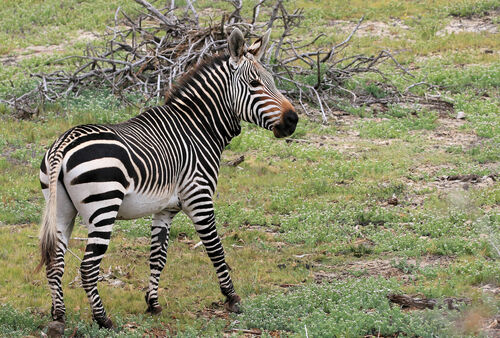
Zebra
Zebras, with their striking black and white stripes, roam the African plains. These social grazers are essential to their ecosystem, promoting grassland diversity. Each species, from the plains-loving Equus quagga to the rare Equus grevyi, boasts unique patterns and social structures, making them a captivating subject of study.
20-30 years
Lifespan
175.0814 - 449.0531 kg
Weight
Length: 2.0 m
Size
Brown, Black, White
Color
3-4 years
Age of Sexual Maturity
7-11 months
Age of Weaning
Characteristics
Zebras are iconic for their black and white striped coats, which vary among species. They inhabit African savannas, grasslands, and woodlands. Social creatures, zebras live in herds and exhibit strong family bonds. They are herbivores, primarily grazing on grasses, and play a crucial role in the ecosystem by maintaining grassland health.
Distribution Range of the Zebra
The species Equus zebra, Equus quagga, and Equus grevyi are collectively known as zebras and are native to various regions across Africa. The Equus zebra, also known as the mountain zebra, is primarily found in the mountainous regions of Namibia and South Africa. The Equus quagga, or plains zebra, is widely distributed across the savannas and grasslands of eastern and southern Africa, including countries such as Kenya, Tanzania, Botswana, Zimbabwe, and South Africa. The Equus grevyi, or Grevy's zebra, inhabits the arid and semi-arid grasslands of Ethiopia and northern Kenya.
Zebra's Habitat
Environmental Conditions
The typical habitat of zebras varies between species. The mountain zebra (Equus zebra) thrives in mountainous, rocky terrain with a preference for elevations up to 2,000 meters, where temperatures are cooler and vegetation includes scrubs and grasses. The plains zebra (Equus quagga) prefers open grasslands and savannas with scattered trees, where rainfall is seasonal and temperatures can be warm. The Grevy's zebra (Equus grevyi) inhabits arid and semi-arid regions, relying on sparse grasslands and bushlands with access to water sources; they are adapted to withstand higher temperatures and more variable rainfall.
Ecological Niche
Zebras play a crucial ecological role as grazers, maintaining the balance of grassland ecosystems. They consume a variety of grasses, which helps control grass growth and promotes biodiversity. Their grazing patterns can influence the distribution of plant species and provide habitats for other wildlife. Zebras also serve as prey for large African predators such as lions, hyenas, and cheetahs, thus playing a key role in the food web. Each species has adapted to its specific ecological niche: mountain zebras are adapted to cooler, rocky environments; plains zebras to open grasslands with seasonal migrations; and Grevy's zebras to drier habitats with a focus on water conservation and efficient foraging.
Copyright @ Nature Style Limited. All Rights Reserved.
 English
English